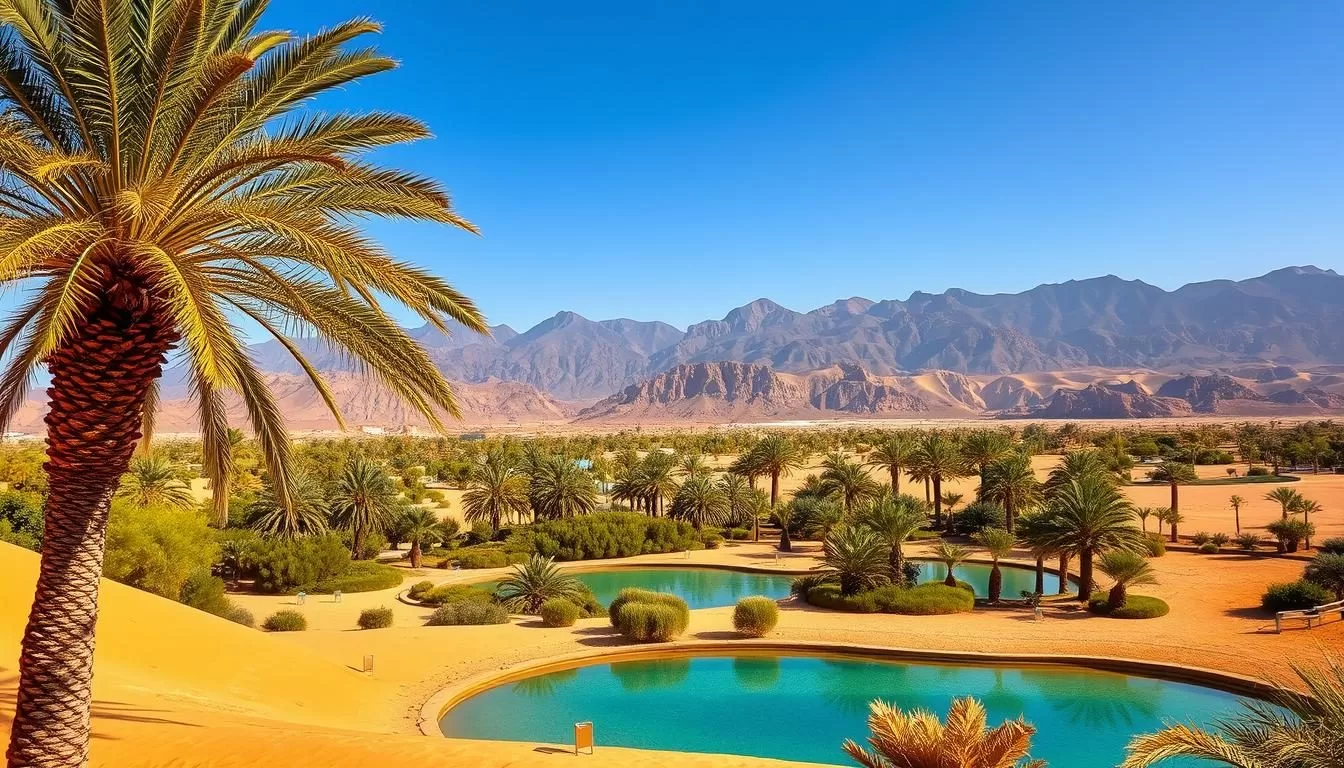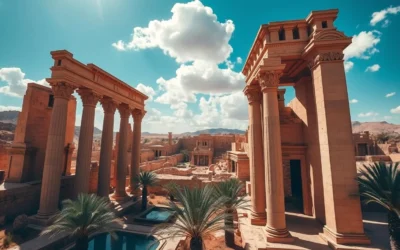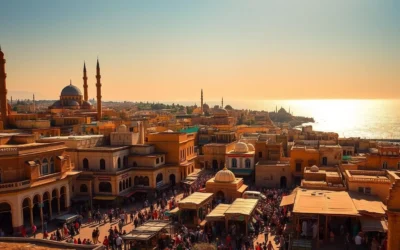Planning a trip to Libya can be a thrilling experience, but it’s crucial to consider the country’s diverse climate zones and seasonal weather patterns.
The country’s climate varies significantly, from the scorching desert heat to the mild Mediterranean weather along its coast. If you’re looking for the best time to visit, the spring (March to May) and autumn (September to November) seasons offer comfortably mild weather, ideal for exploring Libya’s rich archaeological sites and stunning coastline.
During these periods, you can enjoy the temperature that’s not too extreme, making your travel experience more enjoyable. Understanding the seasonal variations will help you make an informed decision about when to visit.
Understanding Libya’s Climate Zones
Understanding the different climate zones in Libya is crucial for planning a trip. Libya’s diverse geography gives rise to varied climate conditions across the country.
Mediterranean Coastal Climate
The Mediterranean coastal region of Libya experiences a mild climate, characterized by warm summers and mild winters. Temperatures during the summer months are usually warm, while winters are generally mild, making this region a favorable destination year-round. The coastal area benefits from a more moderate temperature compared to the harsh conditions found in other parts of the country.

Desert Climate of the Sahara
The Sahara Desert, which dominates much of Libya’s interior, is known for its extreme climate. During the day, temperatures can soar to extremely high levels, often exceeding 104°F (40°C) in the summer. In contrast, night temperatures can drop dramatically, sometimes by as much as 30-40 degrees Fahrenheit. The desert climate is also characterized by intense heat and sun exposure during the day, making it essential for travelers to be well-prepared.
The extreme variations in temperature and the harsh weather conditions make the Sahara Desert one of the most extreme environments in the world, particularly in certain areas.
Libya: Best Months for a Weather-Savvy Trip
Libya’s diverse climate means that the best time to visit varies depending on your preferences and plans. Understanding the seasonal variations is key to making the most of your trip.
Spring Season: March to May
Spring is a wonderful time to visit Libya as the weather transitions from the mild winters to the warmer summer months. During this season, the temperatures are pleasant, making it an ideal time to visit historical sites and explore the desert landscapes without the intense heat of the summer.
The average temperature in March is around 18°C/64°F, gradually rising to about 25°C/77°F by May. This period offers comfortable weather conditions, with mild days and cooler nights, making it perfect for outdoor activities and sightseeing.
Fall Season: September to November
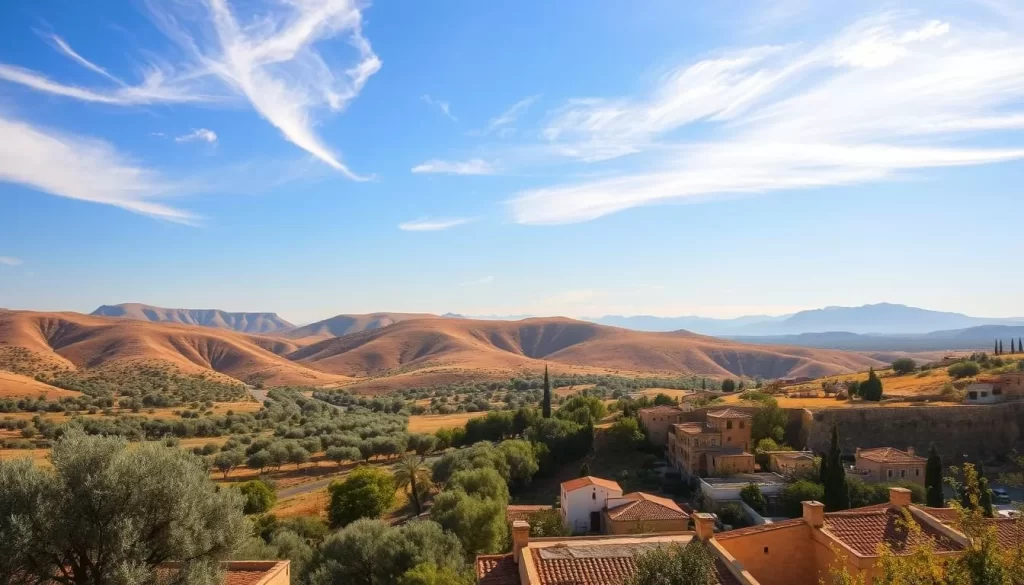 season is another excellent time of year to visit Libya. September still carries some summer warmth but with noticeably cooler evenings, creating comfortable conditions for exploration throughout the day.
season is another excellent time of year to visit Libya. September still carries some summer warmth but with noticeably cooler evenings, creating comfortable conditions for exploration throughout the day.
- October offers nearly perfect weather conditions with warm days, cool nights, and minimal rainfall, making it one of the most popular months to visit.
- November brings cooler temperatures that many travelers find ideal for active sightseeing and desert excursions.
- The fall months provide a pleasant transition from summer heat to winter coolness, with gradually increasing chances of occasional rainfall toward the end of the season, with about 4 days of rainfall in October and 3 days in November.
Summer in Libya: What to Expect
When traveling to Libya in the summer, you should be prepared for intense heat and unique weather phenomena. Summer is a challenging time to visit Libya due to the extreme temperatures and harsh desert climate.
Temperature Extremes
Summer temperatures in Libya can soar to extreme highs, especially in the desert regions. Temperatures can rise dramatically, making it essential to stay hydrated and limit outdoor activities during the hottest parts of the day.
Coastal vs. Inland Summer Conditions
The coastal regions of Libya experience a slightly more moderate climate compared to the inland desert areas. However, the Ghibli wind can bring hot, dusty air from the desert to the coastal regions, significantly impacting the weather conditions. This wind can create challenging conditions for several days at a time.

Managing the Ghibli Wind
The Ghibli wind is a significant weather phenomenon in Libya, characterized by hot, dust-laden air from the Sahara Desert. To manage the effects of the Ghibli wind, travelers should limit outdoor activities, keep windows closed, use air conditioning when available, and drink plenty of water to stay hydrated. Understanding and preparing for this wind is crucial for a comfortable trip.
By being aware of the extreme temperatures and unique weather conditions such as the Ghibli wind, you can better plan your trip to Libya during the summer months and take necessary precautions to ensure a safe and enjoyable journey.
Winter Travel to Libya
Winter in Libya is characterized by varied climate conditions, making it essential to be prepared for your trip.
Temperature Variations
During the winter months, Libya experiences a range of temperatures across different regions. Coastal areas tend to be mild, while the desert interior can be quite cold, especially at night. You should pack layers for your trip to accommodate these variations.
The average temperature in coastal cities like Tripoli during winter ranges from 45°F to 65°F (7°C to 18°C), making it a pleasant time to visit historical sites without the intense heat of the summer.
Rainfall Patterns
Libya’s rainfall is minimal, even during its wet season, which primarily affects the coastal regions. The wettest month is typically December, with an average of 4-5 days of rain.
| Region | Average Annual Rainfall | Wettest Month |
|---|---|---|
| Coastal Areas | 10-16 inches (250-400mm) | December |
| Desert Interior | Less than 2 inches (50mm) | Varies |
Understanding these rainfall patterns helps you prepare for your trip without overpacking rain gear. Winter rainfall can occasionally lead to brief but spectacular desert blooming phenomena.
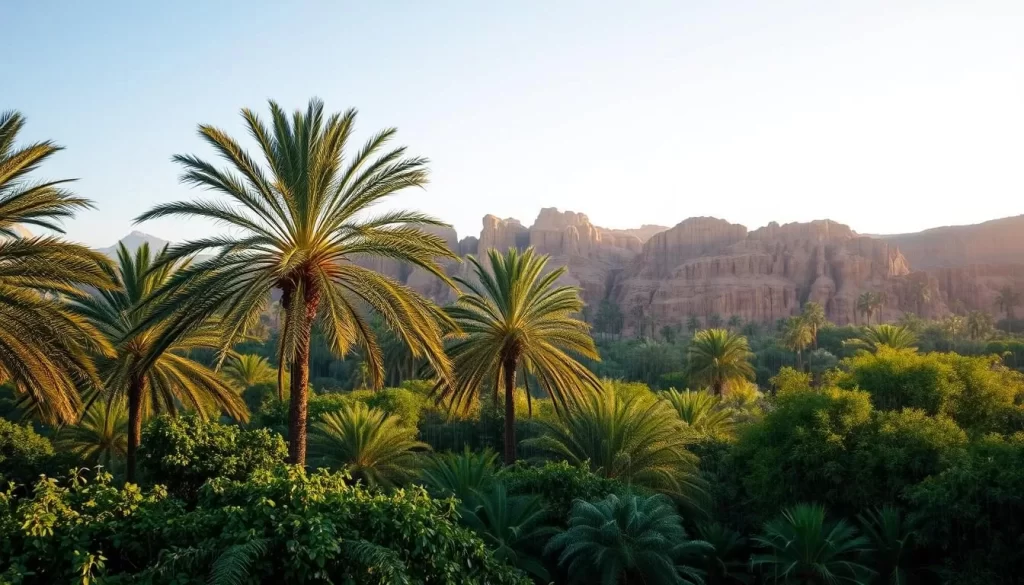
Monthly Weather Breakdown
As you plan your trip to Libya, understanding the monthly weather breakdown is crucial for a comfortable journey. Libya’s climate varies significantly throughout the year, and being prepared for the weather conditions can make a big difference in your travel experience.
January to March
The first quarter of the year in Libya is characterized by cool temperatures, especially in the mornings and evenings. January is one of the coolest months, with average temperatures ranging from 12°C to 18°C (54°F to 64°F). As the months progress, temperatures gradually rise, with March seeing averages of 15°C to 22°C (59°F to 72°F). This period is relatively wet, with most of the country’s annual rainfall occurring during these months.
April to June
As spring transitions into summer, April to June brings warmer temperatures across Libya. April sees average highs of around 25°C (77°F), while June can reach highs of up to 30°C (86°F) or more. The rainfall during this period decreases significantly, making it an ideal time for outdoor activities and sightseeing. The weather during these months is generally pleasant, with mild temperatures and plenty of sunshine.
July to September
Summer in Libya is hot, with July and August being the peak months. Temperatures often soar above 35°C (95°F), especially in the desert regions. The coastal areas are somewhat cooler due to the sea breeze, but the heat is still intense. This period is characterized by very little rainfall, making it essential to stay hydrated and protected from the sun.
October to December
October marks the beginning of more moderate temperatures across Libya, creating excellent conditions for exploration. November continues the cooling trend, with pleasant temperatures ideal for sightseeing. December brings the coolest conditions, with temperatures averaging 14°C (57°F) and increased rainfall, making it one of the wettest months.
| Month | Average Temperature (°C) | Average Rainfall (days) |
|---|---|---|
| October | 25 | 4 |
| November | 20 | 3 |
| December | 14 | 4-5 |
The period from October to December sees a gradual transition from fall to winter conditions, with increasing cloud cover and occasional rainy days. The cooler temperatures create ideal conditions for exploring archaeological sites and urban areas without the discomfort of summer heat.
Best Times for Specific Activities
The right time to visit Libya can significantly enhance your experience, whether you’re exploring the desert or enjoying coastal activities. Libya’s diverse climate means that the best time for your trip depends on what you want to do.
Desert Exploration
For desert exploration, the cooler months from October to April are ideal. During this period, the temperature is more manageable, making it easier to navigate the Sahara’s vast expanses. You can enjoy the serene beauty of the desert without the harsh conditions of the peak summer months.
Archaeological Sites
Visiting archaeological sites is best done during the spring (March to May) or fall (September to November). The weather is pleasant, and the sites are less crowded, allowing for a more enjoyable and peaceful experience. You can explore historical sites like Leptis Magna without the intense sun.
Coastal Activities
For coastal activities, such as swimming and sailing, the water is warmest from June to September, with July and August being the peak months. May and October offer a good balance between pleasant air temperature and warm water, making them excellent alternatives.
Packing Tips for Libya’s Weather
When traveling to Libya, it’s crucial to pack wisely to navigate the country’s diverse weather conditions. Libya’s climate varies significantly across different regions and seasons.
Essential Clothing by Season
For a comfortable trip, pack clothing suitable for the season you’re traveling in. Lightweight, breathable clothing is ideal for the hot day time, while warmer layers may be needed for cooler evenings, especially in the desert.
Weather-Related Gear
Don’t forget to pack essential weather-related gear, including high SPF sunscreen, polarized sunglasses, a wide-brimmed hat, and a refillable water bottle. A dust mask or scarf can protect you from the wind, and a small, packable rain jacket is handy during winter travel.
Conclusion
The key to a successful Libyan adventure lies in timing your visit to coincide with the most favorableweather conditions. The best time to visit Libya is during the spring (March to May) or autumn (September to November), when the climate is mild and ideal for exploring the country’s rich heritage and diverse landscapes.
During these periods, you can comfortably visit Libya’s archaeological sites and enjoy the Mediterranean coastline without the extreme heat of the summer months. By understanding the country’s climate patterns, you can choose the perfect season for your interests and comfort.
Whether you’re interested in desert exploration, historical sites, or coastal activities, Libya has something to offer throughout the year. However, it’s crucial to check current travel advisories and entry requirements before finalizing your plans to ensure a smooth trip.
The above is subject to change.
Check back often to TRAVEL.COM for the latest travel tips and deals.
